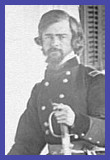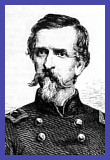Even
though Lee had his second major victory, he did not rest that evening. With
the main Union Army now in disarray, and momentum in his favor, Lee knew
he had an opportunity. Pope's Army was unorganized and retreating to Washington,
DC. Thomas' brigade slept that night, not realizing the next day they would
be marching again. Pope's Army, was out there somewhere, and Lee wanted it
stopped.
At noon the next day, Hill's Division was again on the march. In a steady
rain, the Division marched ten miles in the mud. The rain continued through
the night, and by noon the following day the Division had only sloshed another
three miles. At 2:30, they came upon the flank of the retreating Union Army
at Ox Hill, near the Chantilly Tavern. Jackson rushed his men into formation
across the Little River Turnpike near the intersection of West Oaks Road.
He placed the Stonewall Division on the left, Early's in the center, and
Hill's rushed to the right. Union troops were spotted to the south, and Branch
and Field's regiments were dispatched to stop them. They didn't realize it
but they were soon facing 9 regiments under General Stevens and Reno. At
4:00 PM the battle began, and the two Southern regiment's fell back under
overwhelming numbers. Lightning crashed through the sky, and thunder rolled
as the Union Army advanced. Strong winds ripped across the battlefield, as
dark clouds menaced the soldiers below. As the battle began, sheets of rain
began to fall. Soldiers on both sides did everything they could to keep their
ammunition dry, knowing if their cartridges got wet, they would have to fight
by bayonet.

Isaac
Stevens
courtesy
General
Officers of the Civil War
In
the center, after many color bearers had already fallen, Union General Isaac
Ingalls Stevens, grabbed the colors of the 79th New York and called for the
Scottish Highlanders to follow him. In a blistering volley from factions
of the Early's Division, former territorial governor and first in his class
at West Point, General Isaac Stevens fell. Gregg's battered division now
faced Union troops from the Irish 28th Massachusetts and mostly German 46th
New York. To Gregg's left was the Hays Brigade, part of Early's forces. Furious
that their beloved commander had been killed, the 79th New York and 8th Michigan
moved against them. To Gregg's right, the 50th and 100th Pennsylvania Regiments
were gaining ground quickly against Branch's and Field's division's, who
had been falling back and were now running low on ammunition. Behind Gregg,
was the Thomas brigade, and too thier right, was Pender's brigade. Pender
rushed his brigade forward to support Branch and Field as the Union advance
looked to turn Jackson's right. At about 4:30 PM Thomas' regiment rushed
forward to edge of the cornfield to support Gregg's men, who were being routed.
Thomas' men now faced the fire of the 28th Mass, and soon, were firing upon
the 79th New York, who had routed four of Early's seven divisions. A
historian
from the 79th later wrote, "The enemy were in heavy force on the left,
although driven in the front, and the contest now raged with great fury over
the cornfield."
As the battle raged, Field and Gregg reorganized their troops behind Thomas,
Pender, and Branch. On their left, Early sent reinforcement's to form a second
line of defense behind his three beleaguered regiments. Finally, running
low on ammunition, the 79th New York and 28th Mass began to fall back. Branch,
Pender, and Field's commands moved forward into the muddy field as the Union
moved back slowly, contesting the ground they were giving up. But the advance
would only go as far as the cornfield. Approaching the southern edge, the
three brigade's from Hill's division would run smack into seven fresh regiment's
under General Birney. In charges and counter-charges, the dogged men of Hill's
Division refused to give up the ground they had gained. But eventually, vastly
outnumbered, and under artillery fire, they fell back. With darkness falling,
the Union regiments again advanced thru the muddy cornfield.

Phillip
Kearney
courtesy
General
Officers of the Civil War
On
their right, the remnants of the 21st Mass advanced under the leadership
of one armed General Philip Kearney, the general that had given Hill's men
so much trouble just a few days prior. Kearney had a short fuse. He is credited
with inventing the military unit insignia, after being embarrassed at chewing
out some officers, who turned out not to belong to his command. Annoyed at
the 21st halting their advance, and unconvinced the enemy was close, Kearney
rode out to identify the troops to his front. Approaching a group of soldiers,
he hollered out to them to identify themselves. It was the 49th Georgia of
Thomas' brigade. Kearney wheeled his horse, and tried to escape, but was
shot as he fled.
Within yards of one another, two of the Union's best General's now lay dead.
With ammunition now wet, element's of Thomas brigade and the 21st Mass began
a series of bayonet charges at one another. But darkness fell fast with the
overhanging storm clouds, and soon all grew quiet except for the raging thunder
and the moans of the wounded. By 2:30 am, the Union forces were withdrawing
from the battlefield. It was a draw, a victory, and a defeat for General
Lee. The battle was a draw in that nothing had been gained by either side,
It was a victory in that the Confederate Army held possession of the battlefield.
But it was a loss in that Pope had escaped with the bulk of his Army. With
their lives, General's Kearney and Stevens, and so many of their men, had
bought Pope the time he needed to escape.
For
more information on this battle, including lots of troop movement maps, I
strongly recommend a visit to
The Battle
of Ox
Hill. An excellent and well
done site.
In memory of their fallen leader, in November of 1862, officers of the 1st
Division, 3rd Corps, established a medal of honor, that they called the Kearney
Medal. This medal was given to all officers who had served honorably in battle
under General Kearney. In March of 63, General Birney followed this, by
establishing a cross of valor for all non-commissioned soldiers and privates
who had distinguished themselves in battle. In July of that year, the US
Congress would adopt Birney's principle, and designated new guidelines by
which such medal's of honor could be presented. Today this medal is known
as the Congressional Medal
of Honor.
More on Gen Isaac
Stevens
35th
Georgia Index
|

